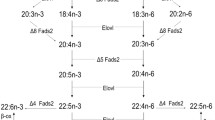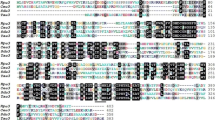Abstract
Long-chain polyunsaturated fatty acids (LC-PUFA) have been identified as essential compounds for common octopus (Octopus vulgaris), but precise dietary requirements have not been determined due, in part, to the inherent difficulties of performing feeding trials on paralarvae. Our objective is to establish the essential fatty acid (EFA) requirements for paralarval stages of the common octopus through characterisation of the enzymes of endogenous LC-PUFA biosynthetic pathways. In this study, we isolated a cDNA with high homology to fatty acyl desaturases (Fad). Functional characterisation in recombinant yeast showed that the octopus Fad exhibited Δ5-desaturation activity towards saturated and polyunsaturated fatty acyl substrates. Thus, it efficiently converted the yeast’s endogenous 16:0 and 18:0 to 16:1n-11 and 18:1n-13, respectively, and desaturated exogenously added PUFA substrates 20:4n-3 and 20:3n-6 to 20:5n-3 (EPA) and 20:4n-6 (ARA), respectively. Although the Δ5 Fad enables common octopus to produce EPA and ARA, the low availability of its adequate substrates 20:4n-3 and 20:3n-6, either in the diet or by limited endogenous synthesis from C18 PUFA, might indicate that EPA and ARA are indeed EFA for this species. Interestingly, the octopus Δ5 Fad can also participate in the biosynthesis of non-methylene-interrupted FA, PUFA that are generally uncommon in vertebrates but have been found previously in marine invertebrates, including molluscs, and now also confirmed to be present in specific tissues of common octopus.




Similar content being viewed by others
References
Agaba M, Tocher DR, Dickson C, Dick JR, Teale AJ (2004) Zebrafish cDNA encoding multifunctional fatty acid elongase involved in production of eicosapentaenoic (20:5n-3) and docosahexaenoic (22:6n-3) acids. Mar Biotechnol 6:251–261
Barnathan G (2009) Non-methylene-interrupted fatty acids from marine invertebrates: occurrence, characterization and biological properties. Biochimie 91:671–678
Beaudoin F, Michaelson LV, Lewis MJ, Shewry PR, Sayanova O, Napier JA (2000) Production of C20 polyunsaturated fatty acids (PUFAs) by pathway engineering: identification of a PUFA elongase component from Caenorhabditis elegans. Biochem Soc Trans 28:661–663
Bell MV, Tocher DR (2009) In: Arts MT, Brett M, Kainz M (eds) Lipids in aquatic ecosystems. Springer-Verlag, New York
Castro LFC, Wilson JM, Gonçalves O, Galante-Oliveira S, Rocha E, Cunha I (2011) The evolutionary history of the stearoyl-CoA desaturase gene family in vertebrates. BMC Evol 11:132
Chu FE, Greaves J (1991) Metabolism of palmitic, linoleic, and linolenic acid in adult oyster, Crassostrea virginica. Mar Biol 110:229–236
David E, Tanguy A, Pichavant K, Moraga D (2005) Response of the Pacific oyster Crassostrea gigas to hypoxia exposure under experimental conditions. FEBS J 272:5635–5652
De Moreno JEA, Moreno VJ, Brenner RR (1976) Lipid metabolism of the yellow clam, Mesodesma mactroides: 2-polyunsaturated fatty acid metabolism. Lipids 11:561–566
Destaillats F, Angers P (2002) One-step methodology for the synthesis of FA picolinyl esters from intact lipids. J Am Oil Chem Soc 79:253–256
Estefanell J, Socorro J, Roo FJ, Fernández-Palacios H, Izquierdo M (2010) Gonad maturation in Octopus vulgaris during ongrowing, under different conditions of sex ratio. ICES J Mar Sci 67:1487–1493
Ge L, Gordon JS, Hsuan C, Stenn K, Prouty SM (2003) Identification of the Δ-6 desaturase of human sebaceous glands: expression and enzyme activity. J Invest Dermatol 120:707–714
Guillou H, Zadravec D, Martin PGP, Jacobsson A (2010) The key roles of elongases and desaturases in mammalian fatty acid metabolism: insights from transgenic mice. Prog Lipid Res 49:186–199
Hashimoto K, Yoshizawa AC, Okuda S, Kuma K, Goto S, Kanehisa M (2008) The repertoire of desaturases and elongases reveals fatty acid variations in 56 eukaryotic genomes. J Lipid Res 49:183–191
Hastings N, Agaba M, Tocher DR, Leaver MJ, Dick JR, Sargent JR, Teale AJ (2001) A vertebrate fatty acid desaturase with Δ5 and Δ6 activities. Proc Natl Acad Sci USA 98:14304–14309
Iglesias J, Fuentes L, Sánchez J, Otero JJ, Moxica C, Lago MJ (2006) First feeding of Octopus vulgaris Cuvier, 1797 paralarvae using Artemia: effect of prey size, prey density and feeding frequency. Aquaculture 261:817–822
Iglesias J, Sánchez FJ, Bersano JGF, Carrasco JF, Dhont J, Fuentes L, Linares F, Muñoz JL, Okumura S, Roo J, van der Meeren T, Vidal EAG, Villanueva R (2007) Rearing of Octopus vulgaris paralarvae: present status, bottlenecks and trends. Aquaculture 266:1–15
Innis SM, Sprecher H, Hachey D, Edmond J, Anderson RE (1999) Neonatal polyunsaturated fatty acid metabolism. Lipids 34:139–149
Jakobsson A, Westerberg R, Jacobsson A (2006) Fatty acid elongases in mammals: their regulation and roles in metabolism. Prog Lipid Res 45:237–249
Joseph JD (1982) Lipid composition of marine and estuarine invertebrates. Part II: Mollusca. Prog Lipid Res 21:109–153
Kawashima H (2005) Unusual minor nonmethylene-interrupted di-, tri-, and tetraenoic fatty acids in limpet gonads. Lipids 40:627–630
Kawashima H, Ohnishi M (2004) Identification of minor fatty acids and various nonmethylene-interrupted diene isomers in mantle, muscle, and viscera of the marine bivalve Megangulus zyonoensis. Lipids 39:265–271
Kornprobst JM, Barnathan G (2010) Demospongic acids revisited. Mar Drugs 8:2569–2577
Lauritzen L, Hansen HS, Jørgensen MH, Michaelsen KF (2001) The essentiality of long chain n-3 fatty acids in relation to development and function of the brain and retina. Prog Lipid Res 40:1–94
Li Y, Monroig Ó, Zhang L, Wang S, Zheng X, Dick JR, You C, Tocher DR (2010) Vertebrate fatty acyl desaturase with Δ4 activity. Proc Natl Acad Sci USA 107:16840–16845
López Alonso D, García-Maroto F, Rodríguez-Ruiz J, Garrido JA, Vilches MA (2003) Evolution of the membrane-bound fatty acid desaturases. Biochem Syst Ecol 31:1111–1112
Milou H, Fintikaki M, Tzitzinakis M, Kountouris T, Virriopoulos G (2006) Fatty acid composition of the common octopus, Octopus vulgaris, in relation to rearing temperature and body weight. Aquaculture 256:311–322
Monroig Ó, Rotllant J, Sánchez E, Cerdá-Reverter JM, Tocher DR (2009) Expression of long-chain polyunsaturated fatty acid (LC-PUFA) biosynthesis genes during zebrafish Danio rerio early embryogenesis. Biochim Biophys Acta 1791:1093–1101
Monroig Ó, Zheng X, Morais S, Leaver MJ, Taggart JB, Tocher DR (2010) Multiple genes for functional Δ6 fatty acyl desaturases (Fad) in Atlantic salmon (Salmo salar L.): gene and cDNA characterization, functional expression, tissue distribution and nutritional regulation. Biochim Biophys Acta 1801:1072–1081
Monroig Ó, Li Y, Tocher DR (2011) Delta-8 desaturation activity varies among fatty acyl desaturases of teleost fish: high activity in delta-6 desaturases of marine species. Comp Biochem Physiol 159B:206–213
Napier JA, Sayanova O, Sperling P, Heinz E (1999) A growing family of cytochrome b(5)-domain fusion proteins. Trends Plant Sci 4:2–4
Navarro JC, Villanueva R (2000) Lipid and fatty acid composition of early stages of cephalopods: an approach to their lipid requirements. Aquaculture 183:161–177
Navarro JC, Villanueva R (2003) The fatty acid composition of Octopus vulgaris paralarvae reared with live and inert food: deviation from their natural fatty acid profile. Aquaculture 219:613–631
Otero J, González ÁF, Sieiro MP, Guerra Á (2007) Reproductive cycle and energy allocation of Octopus vulgaris in Galician waters, NE Atlantic. Fish Res 85:122–129
Pirini M, Manuzzi MP, Pagliarani A, Trombetti F, Borgatti AR, Ventrella V (2007) Changes in fatty acid composition of Mytilus galloprovincialis (Lmk) fed on microalgal and wheat germ diets. Comp Biochem Physiol 147B:616–626
Qiu X, Hong H, MacKenzie SL (2001) Identification of a Δ4 fatty acid desaturase from Thraustochytrium sp. involved in the biosynthesis of docosahexanoic acid by heterologous expression in Saccharomyces cerevisiae and Brassica juncea. J Biol Chem 276:31561–31566
Quintana D (2009) Valoración de los requerimientos nutricionales de reproductores de pulpo común (Octopus vulgaris). PhD Thesis. Universidad de La Laguna.
Rosa R, Marques AM, Nunes ML, Bandarra N, Sousa Reis C (2004) Spatial-temporal changes in dimethyl acetal (octadecanal) levels of Octopus vulgaris (Mollusca: Cephalopoda): relation to feeding ecology. Sci Mar 68:227–236
Saitou N, Nei M (1987) The neighbor-joining method. A new method for reconstructing phylogenetic trees. Mol Biol Evol 4:406–425
Seixas P, Rey-Méndez M, Valente LMP, Otero A (2008) Producing juvenile Artemia as prey for Octopus vulgaris paralarvae with different microalgal species of controlled biochemical composition. Aquaculture 283:83–91
Seixas P, Otero A, Valente LMP, Dias J, Rey-Méndez M (2010) Growth and fatty acid composition of Octopus vulgaris paralarvae fed with enriched Artemia or co-fed with an inert diet. Aquacult Int 18:1121–1135
Sperling P, Ternes P, Zank TK, Heinz E (2003) The evolution of desaturases. Prostaglandins Leukot Essent Fatty Acids 68:73–95
Van der Horst DJ (1973) Biosynthesis of saturated and unsaturated fatty acids in the pulmonate land snail Cepaea nemoralis (L.). Comp Biochem Physiol 46:551–560
Van der Horst DJ (1974) In vivo biosynthesis of fatty acids in the pulmonate land snail Cepaea nemoralis (L.) under anoxic conditions. Comp Biochem Physiol 47B:181–187
Viciano E, Iglesias J, Lago MJ, Sánchez FJ, Otero JJ, Navarro JC (2011) Fatty acid composition of polar and neutral lipid fractions of Octopus vulgaris Cuvier, 1797 paralarvae reared with enriched on-grown Artemia. Aquacult Res 42:704–709
Villanueva R (1994) Decapod crab zoeae as food for rearing cephalopod paralarvae. Aquaculture 128:143–152
Villanueva R (1995) Experimental rearing and growth of planktonic Octopus vulgaris from hatching to settlement. Can J Fish Aquat Sci 52:2639–2650
Villanueva R, Bustamante P (2006) Composition in essential and non-essential elements of early stages of cephalopods and dietary effects on the elemental profiles of Octopus vulgaris paralarvae. Aquaculture 261:225–240
Villanueva R, Riba J, Ruíz-Capillas C, Gonzaález AV, Baeta M (2004) Amino acid composition of early stages of cephalopods and effects of amo acid dietary treatments on Octopus vulgaris paralarvae. Aquaculture 242:455–478
Villanueva R, Escudero JM, Deulofeu R, Bozzano A, Casoliva C (2009) Vitamin A and E content in early stages of cephalopods and their dietary effects in Octopus vulgaris paralarvae. Aquaculture 286:277–282
Waldock MJ, Holland DL (1984) Fatty acid metabolism in young oysters, Crassostrea gigas: polyunsaturated fatty acids. Lipids 19:332–336
Watts J, Browse J (2002) Genetic dissection of polyunsaturated fatty acid synthesis in Caenorhabditis elegans. Proc Natl Acad Sci USA 99:5854–5859
Watts JL, Phillips E, Griffing KR, Browse J (2003) Deficiencies of C20 polyunsaturated fatty acids cause behavioral and developmental defects in Caenorhabditis elegans fat-3 mutants. Genetics 163:581–589
Weinert J, Blomquist GJ, Borgeson CE (1993) De novo biosynthesis of linoleic acid in two non-insect invertebrates: the land slug and the garden snail. Experientia 49:919–921
Wodinsky J (2008) Reversal and transfer of spermatophores by Octopus vulgaris and O. hummelincki. Mar Biol 155:91–103
Zheng X, Seiliez I, Hastings N, Tocher DR, Panserat S, Dickson CA, Bergot P, Teale AJ (2004) Characterization and comparison of fatty acyl Δ6 desaturase cDNAs from freshwater and marine teleost fish species. Comp Biochem Physiol 139B:269–279
Zheng X, Tocher DR, Dickson CA, Dick JR, Bell JG, Teale AJ (2005) Highly unsaturated fatty acid synthesis in vertebrates: new insights with the cloning and characterisation of a Δ6 desaturase of Atlantic salmon. Lipids 40:13–24
Zheng X, Ding Z, Xu Y, Monroig O, Morais S, Tocher DR (2009) Physiological roles of fatty acyl desaturase and elongase in marine fish: characterisation of cDNAs of fatty acyl Δ6 desaturase and Elovl5 elongase of cobia (Rachycentron canadum). Aquaculture 290:122–131
Zhu N, Dai X, Lin DS, Connor WE (1994) The lipids of slugs and snails: evolution, diet and biosynthesis. Lipids 29:869–875
Zhukova NV (1986) Biosynthesis of non-methylene-interrupted dienoic fatty acids from 14 C-acetate in molluscs. Biochim Biophys Acta 878:131–133
Zhukova NV (1991) The pathway of the biosynthesis of non-methylene-interrupted dienoic fatty acids in molluscs. Comp Biochem Physiol 100B:801–804
Zhukova NV (2007) Lipid classes and fatty acid composition of the tropical nudibranch mollusks Chromodoris sp. and Phyllidia coelestis. Lipids 42:1169–1175
Acknowledgements
This research and OM were supported by a Marie Curie Reintegration Grant within the 7th European Community Framework Programme (PERG08-GA-2010-276916, LONGFA), with additional support from ‘Ministerio de Ciencia e Innovación’ through the OCTOPHYS Project (AGL-2010-22120-C03-02) and a Juan de la Cierva postdoctoral contract for OM, and the Generalitat Valenciana through a PROMETEO Project (2010/006).
Author information
Authors and Affiliations
Corresponding author
Rights and permissions
About this article
Cite this article
Monroig, Ó., Navarro, J.C., Dick, J.R. et al. Identification of a Δ5-like Fatty Acyl Desaturase from the Cephalopod Octopus vulgaris (Cuvier 1797) Involved in the Biosynthesis of Essential Fatty Acids. Mar Biotechnol 14, 411–422 (2012). https://doi.org/10.1007/s10126-011-9423-2
Received:
Accepted:
Published:
Issue Date:
DOI: https://doi.org/10.1007/s10126-011-9423-2




